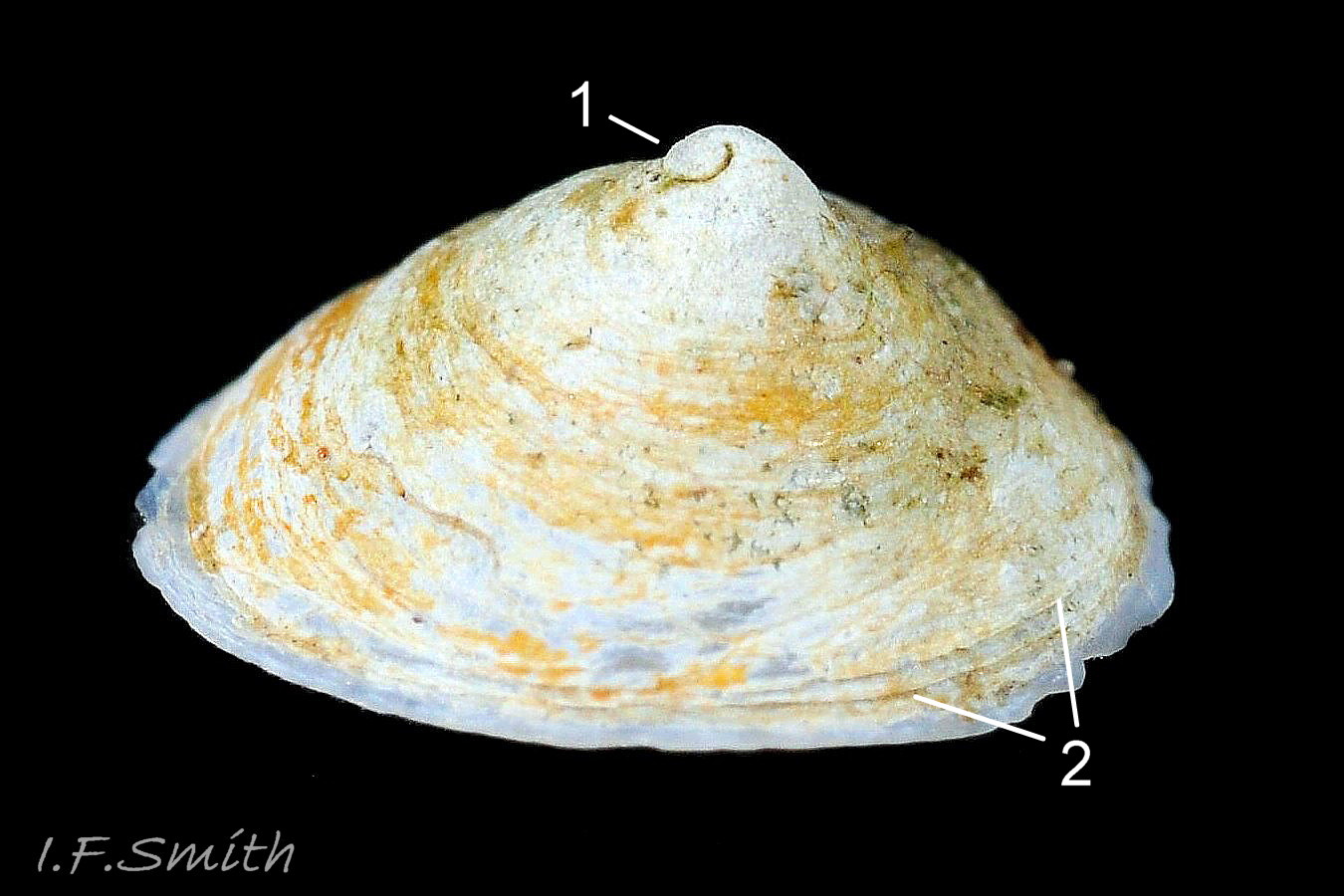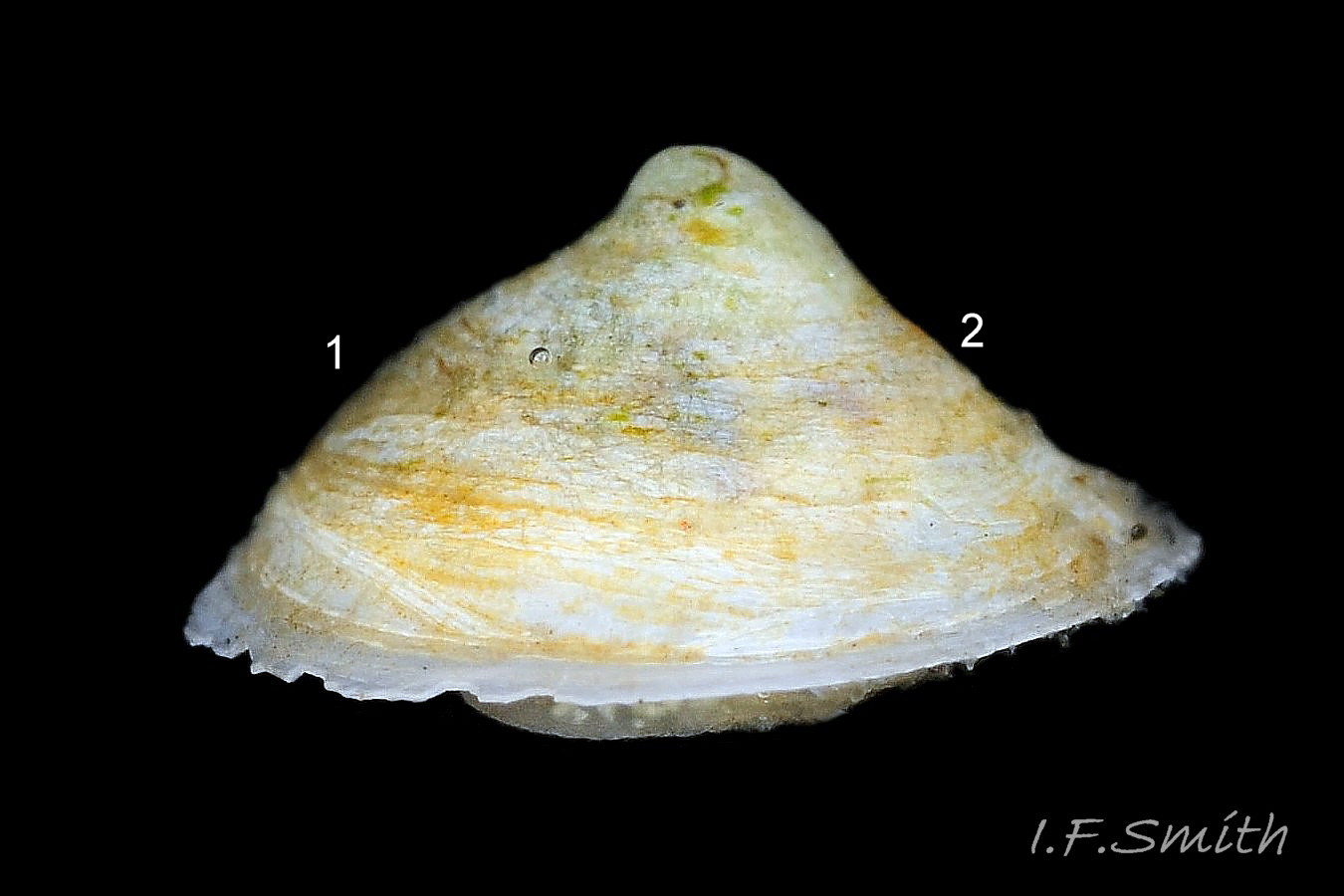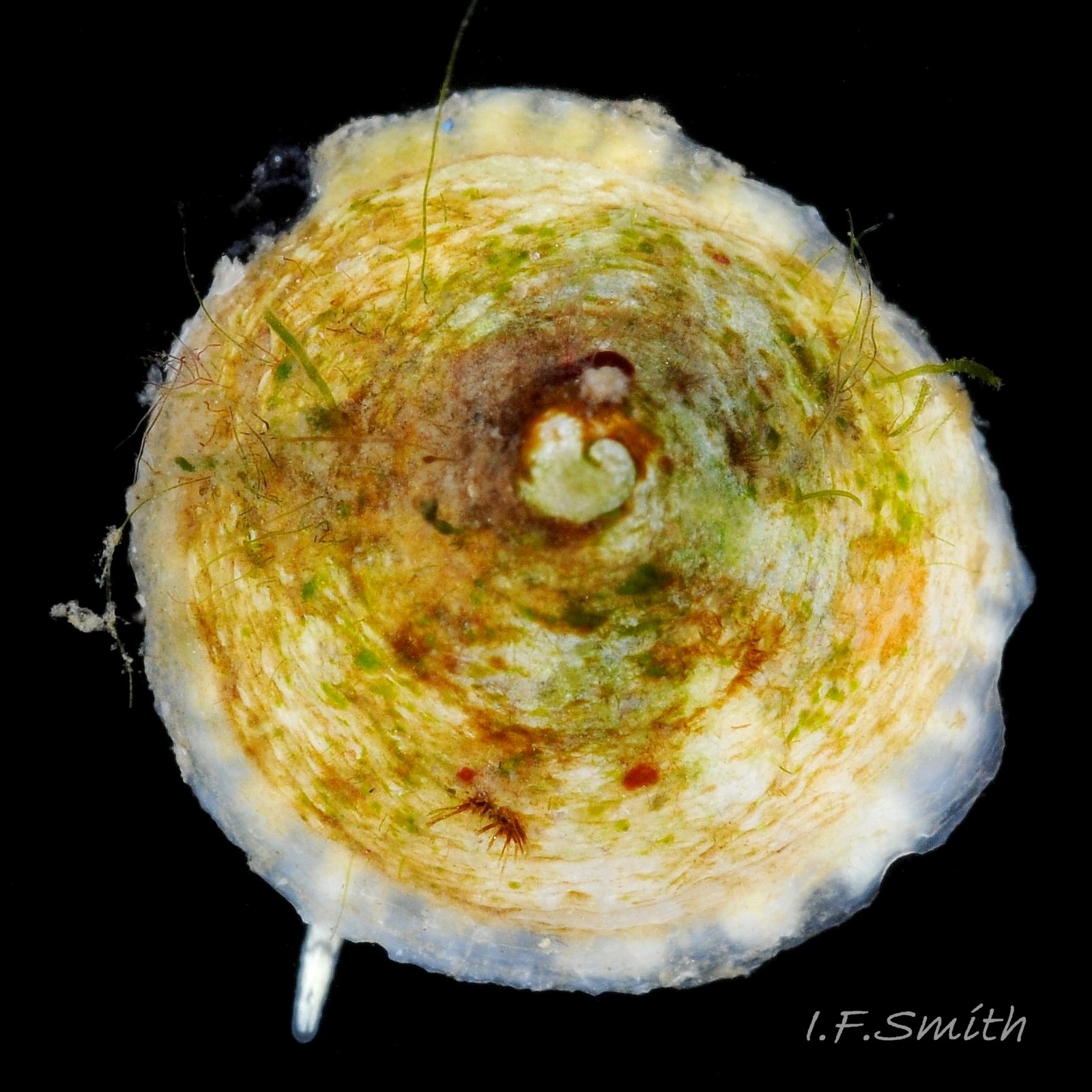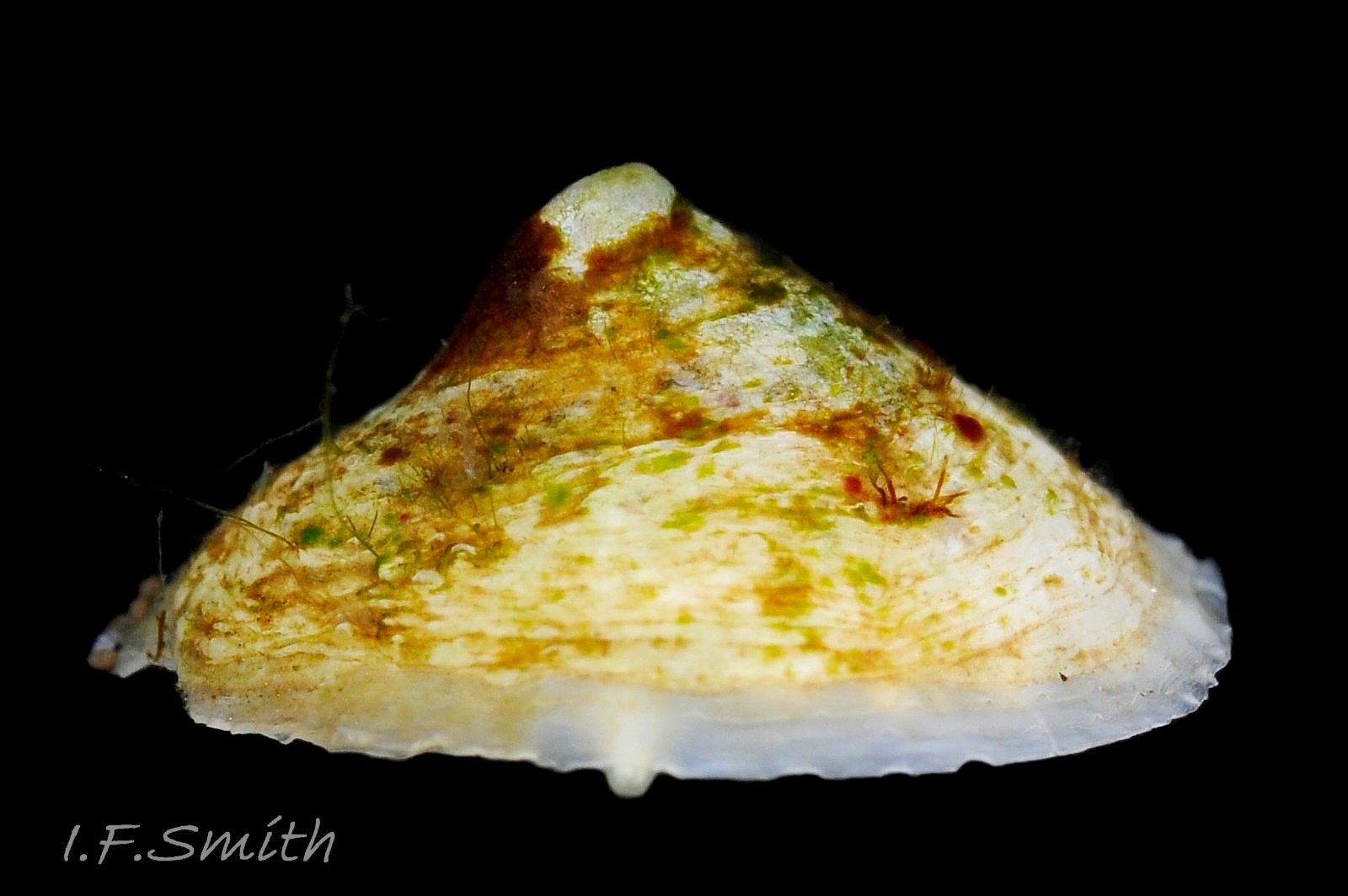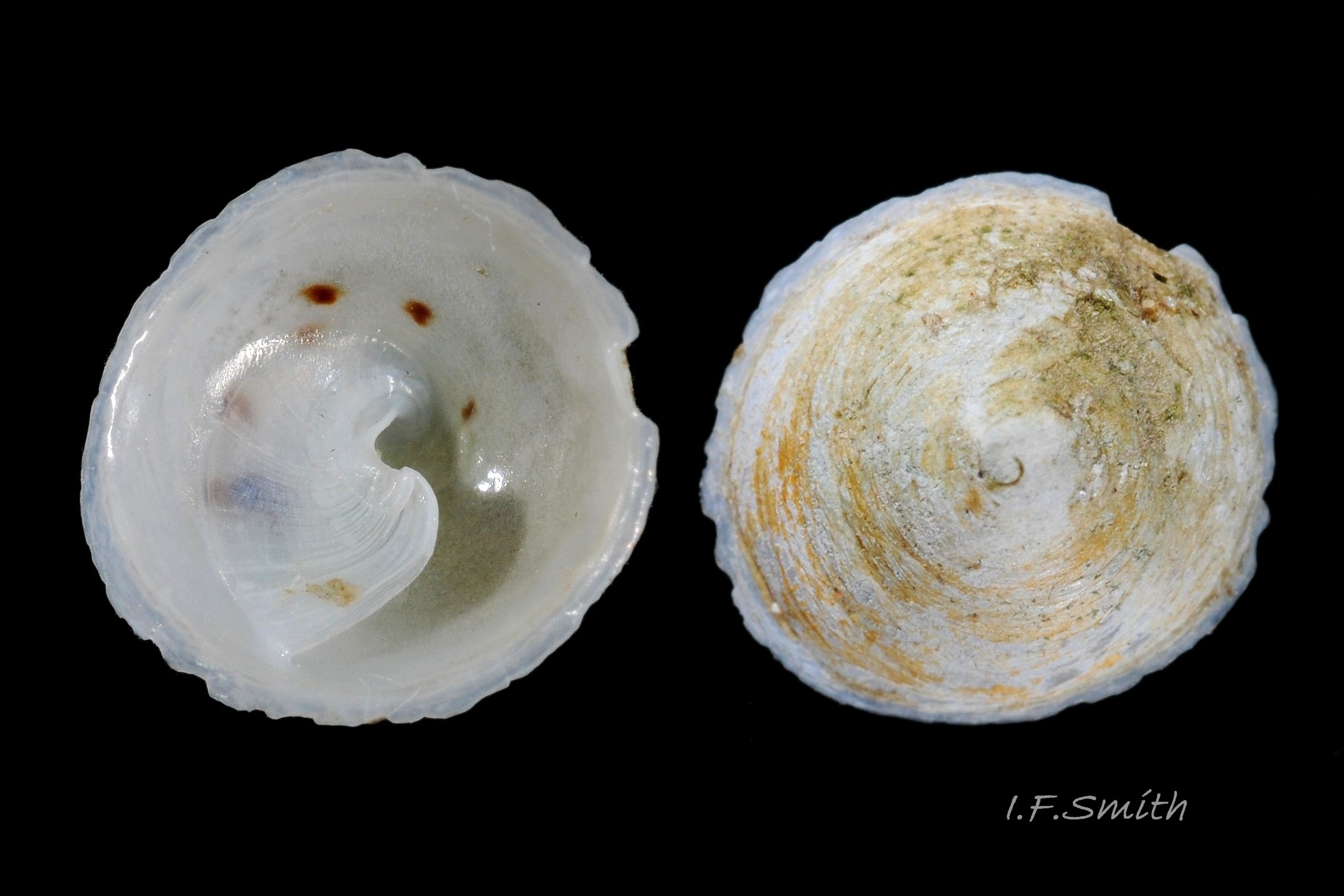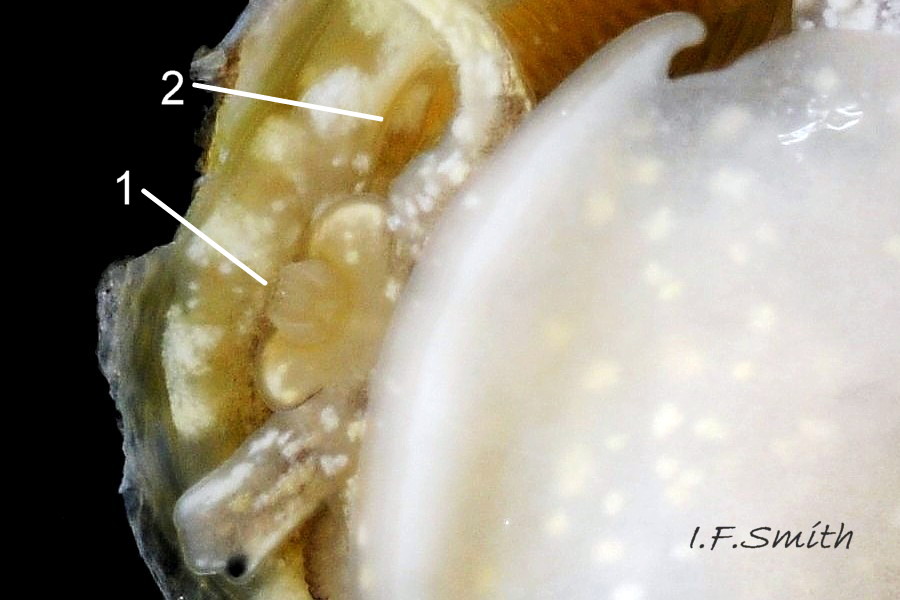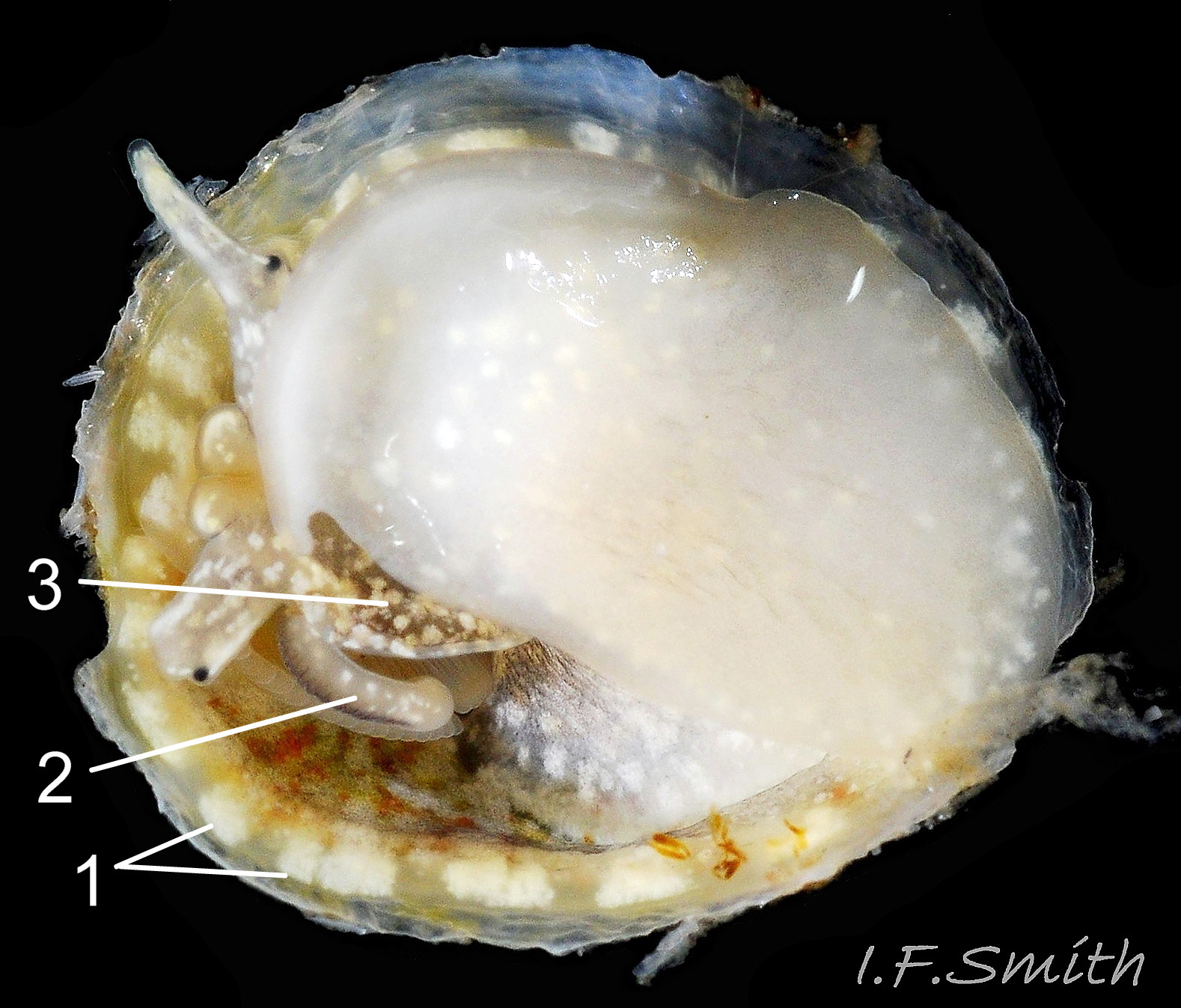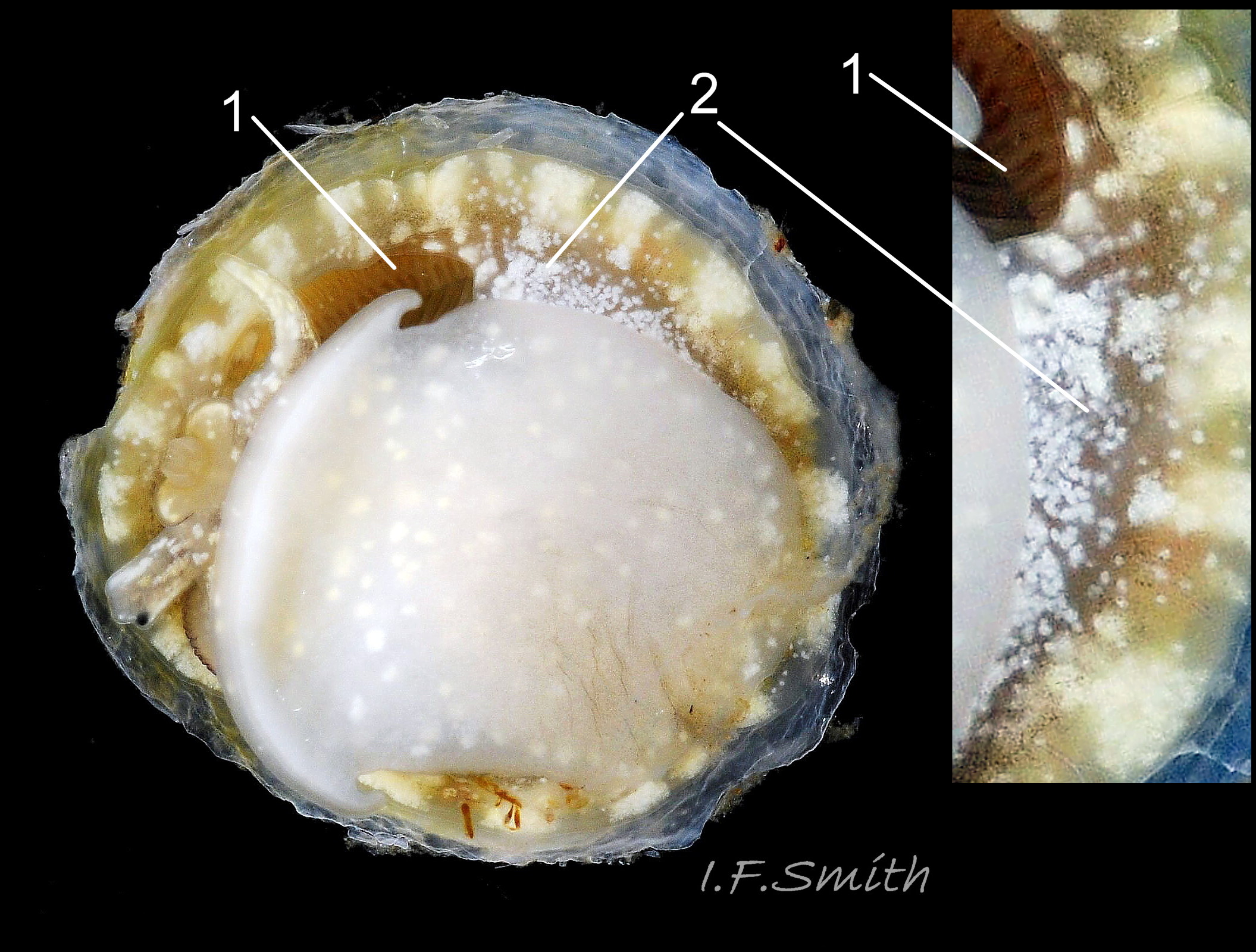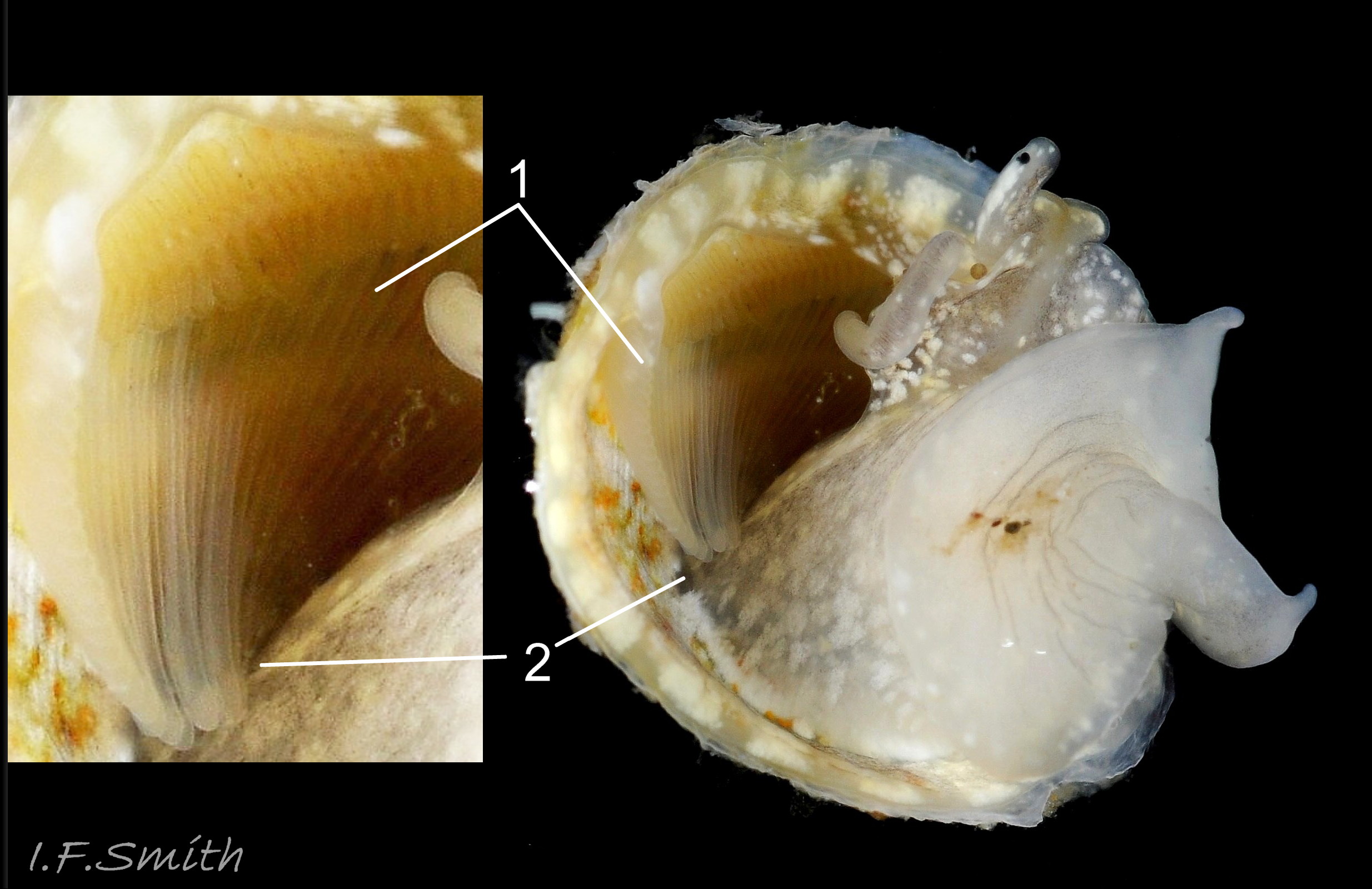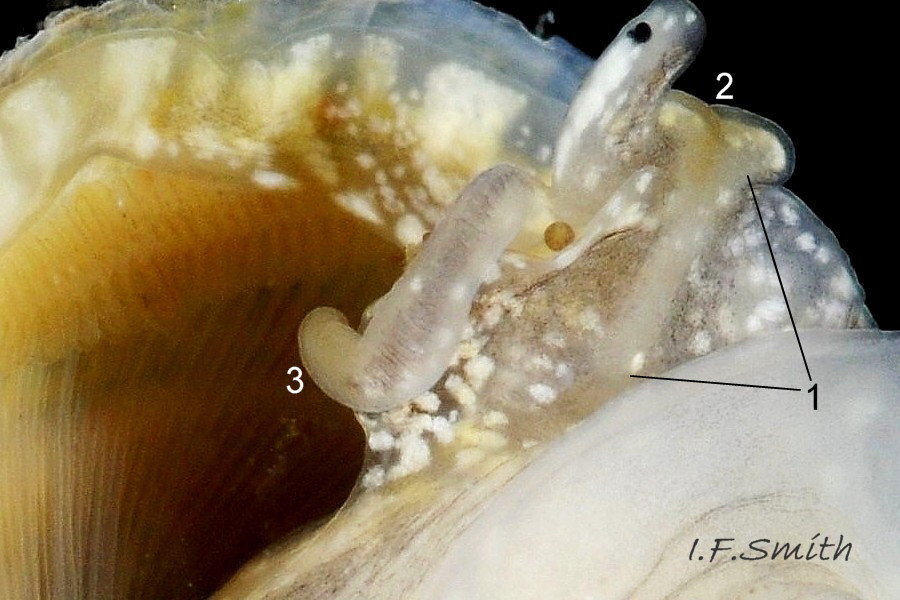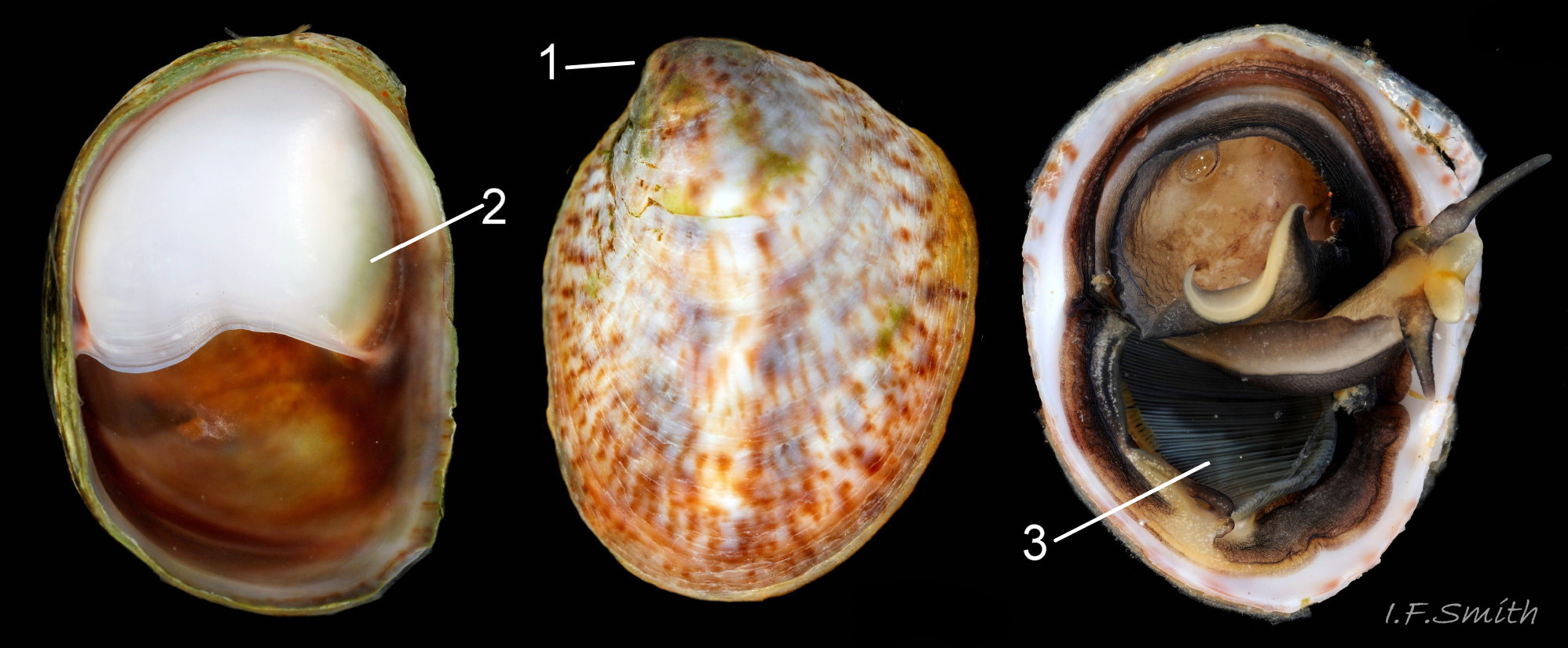Click image to enlarge with full caption
Calyptraea chinensis (Linnaeus, 1758)
PDF available at https://www.researchgate.net/publication/376415643_Calyptraea_chinensis_Linnaeus_1758
Current taxonomy: World Register of Marine Species (WoRMS) www.marinespecies.org/aphia.php?p=taxdetails&id=138961
Synonyms: Patella chinensis Linnaeus, 1758; Calyptraea sinensis (Linnaeus, 1758);
Vernacular: Chinaman’s hat; Chinese hat shell; Cup and saucer limpet; Het Tsieinî (Welsh); Chinees hoedje (Dutch); Chapaeu chinois (French); Chinesenhut (German); Kineziko kapelo (Greek).
Glossary below.
Shell Description
Patelliform cone (= body whorl) lacking any spire except one and half tiny whorls of larval protoconch at apex 01 Calyptraea chinensis which is often eroded away in later adult life. Cone of female up to 5mm high; diameter of near-circular aperture usually up to 15mm, exceptionally 21mm; males maximum diameter about 8mm. Profile of cone has concave anterior and convex posterior 02 Calyptraea chinensis. Individuals living on pebble often steeper than those on flatter surfaces. Apex almost central 03 Calyptraea chinensis, quite sharp with nipple-like tip if protoconch not eroded 04 Calyptraea chinensis. No external sculpture apart from protoconch and concentric growth lines 01 Calyptraea chinensis , but sometimes the cone is stepped, and/or have small tubercles (Wigham & Graham, 2017). Posterior half of interior partitioned by tongue-shaped, shelf-like septum, originating narrowly at apex and widening through half a helical spiral turn to near the thin bevelled rim of the aperture 05 Calyptraea chinensis As with other patelliform species, the larval operculum is lost on metamorphosis to adult form. The shell has an unpatterned, matt, whitish or yellowish exterior. The thin perimeter is often translucent 03 Calyptraea chinensis and the shiny pearl-white interior occasionally has brown blemishes. Thin yellowish periostracum often eroded 01 Calyptraea chinensis
Body Description
Translucent white, fawn-white or grey-white 09 Calyptraea chinensis with many flakes of opaque white. The short snout consists of two distinct lobes separated by a narrow groove 06 Calyptraea chinensis. which opens widely when the radula protrudes 07 Calyptraea chinensis. Cephalic tentacle either side of snout has smooth, stout, cylindrical base with eye, and a rough, tapering, more yellowish, distal half 06 Calyptraea chinensis. Small semicircular neck-lobe behind each tentacle 08 Calyptraea chinensis. Shell muscle attached to septum of shell. Anterior of oval foot bilaminate with small propodial extensions 09 Calyptraea chinensis. Sole translucent whitish with opaque white marks 09 Calyptraea chinensis. Mantle similar colours to body, but may be more yellowish and have orange marks 08 Calyptraea chinensis. Pallial filter of porous sheet of mucus flecked with opaque white stretches from mantle skirt to left (inhalent) side of body 06 Calyptraea chinensis. & 10 Calyptraea chinensis. A pallial food groove and food pocket 10 Calyptraea chinensis are set into the anterior-left of the mantle skirt. Large, deep mantle cavity occupies anterior half of shell. Monopectinate ctenidium many times larger than usual on gastropods 11 Calyptraea chinensis. ; greatly elongated filaments hang from roof of mantle cavity with tips resting on food groove on floor of cavity. Male has wrinkled cylindrical penis with thickened tip 12 Calyptraea chinensis. that distends into bilobed swollen end during copulation .
Key identification features
Calyptraea chinensis
1) Patelliform cone with near central apex 03 Calyptraea chinensis.
2) Near circular aperture with internal septum (shelf) 05 Calyptraea chinensis.
3) Body translucent white, fawn-white or grey-white with flakes of opaque white 06 Calyptraea chinensis.
4) Very large whitish or yellow-white ctenidium 11 Calyptraea chinensis.
Similar species
Patella spp. and other limpets.
2) Conical shell with no internal septum (shelf).
4) No ctenidium (Patella spp.) or small ctenidium (some other limpets).
Crepidula fornicata 13 Calyptraea chinensis
1) Reniform vaulted shell with small depressed spire at one end 01 Crepidula fornicata.
2) Reniform aperture with internal septum (shelf) 03 Crepidula fornicata.
3) Usually, some parts of body blackish 06 Crepidula fornicata.
4) Very large blackish ctenidium 06 Crepidula fornicata .
Habits and ecology
C. chinensis is one of only a handful of British gastropods which feed exclusively like bivalves by filtering phytoplankton and suspended organic particles from the water; it is one of the most perfectly adapted to this mode of life (Fretter & Graham, 1962). Others are Crepidula fornicata, Turritella communis, Capulus ungaricus, Viviparus contectus and Bithynia tentaculata. A strong transverse, left to right, respiratory current is created by cilia covering the large ctenidium 11 Calyptraea chinensis. The current carries in large amounts of food material. A web of mucous threads forms a pallial filter across the entrance to the mantle cavity to the left of the head 06 Calyptraea chinensis. & 10 Calyptraea chinensis. Large food particles are caught by it from the inhalant current and moved by cilia along a pallial groove, which protects the food from contamination by faeces, to a food pocket in the mantle where it is stored 10 Calyptraea chinensis. When required, the radula licks food into the mouth 10 Calyptraea chinensis. There is minimal wear on the teeth of the radula as the diet is entirely soft. Smaller food particles pass through the pallial filter to the ctenidium where they are caught by the branchial filter consisting of porous sheets of mucus coating both sides of the ctenidium. The sheets of mucus are constantly growing and being driven with attached food down the ctenidium to the ciliated food track 11 Calyptraea chinensis on the floor of the mantle cavity where they are shaped into rolls. Cilia carry the rolls along the track across the base of the right neck-lobe to the mouth 12 Calyptraea . Unlike the pallial groove, the food track is exposed to occasional faecal contamination.
Defence against attack provided by shell, and by repugnatorial glands embedded in mantle edge 08 Calyptraea chinensis which give off repellent protein in persistent threads when violently stimulated (Fretter & Graham, 1962).
Reproduction: small males ride on larger older females while mating with substantial penis; in all months, peak Oct-April. During copulation, bilobed tip of penis distends to grip wall of upper end of pallial oviduct. Female spawns twice a year (April- September at Plymouth, December to May at Naples). Very soft, thin-walled, triangular, 3mm long capsules containing 12-24 ova each, laid April-September (Plymouth). Female holds capsules with front of foot for a time before attaching by thin end to substrate under anterior part of her shell in course of strong inhalent current. Ova concentrated in wide end of capsules. Female incubates them until, having passed the veliger stage within the capsules, the young emerge as crawling juveniles with embryonic spiral shell of one and a half coils.
C. chinensis is protandrous sequential hermaphrodite; all young are born as males and function as males through the first breeding season lasting 3-4months. Then remaining sperm absorbed, penis reduced and lost, and open-groove vas deferens closes to form oviduct as male changes to live on one or two years as a functioning female. Change is always at same development stage; not controlled by environmental factors or proximity of other C. chinensis individuals.
Distribution and status
C. chinensis is native to the Mediterranean and west Europe as far north as southern Britain. Its specific epithet refers to the shape of a stereotypical Chinese hat, not occurrence in China. The GBIF map at www.gbif.org/species/2301629 shows records scattered across the world. Some may be introductions with commercially translocated shellfish, but those located inland are obviously misidentifications, confused locations or fossils, and others may be also. In the British Isles it is most frequent, occurring sublittorally and littorally, on the south coast of England from west of Sussex to Cornwall, and in south-west Wales. Beyond that area, there are scattered sublittoral, and some littoral, records up the west coast as far as Shetland and in Ireland 14 Calyptraea chinensis . Some may have been introduced accidentally by humans with translocated shellfish. U.K. distribution map NBN https://species.nbnatlas.org/species/NBNSYS0000174315
Links and references
Forbes, E. & Hanley S. 1849-53. A history of the British mollusca and their shells. vol. 2 (1849). London, van Voorst. (As Calyptraea sinensis ; Free pdf at archive.org/details/historyofbritish02forb Use slide at base of page to select pp.463-465)
Fretter, V. and Graham, A. 1962.British prosobranch molluscs. London, Ray Society.
Graham, A. 1988. Molluscs: prosobranch and pyramidellid gastropods. Synopses of the British Fauna (New Series) no.2 (Second edition). Leiden, E.J.Brill/Dr. W. Backhuys. pp.662.
Jeffreys, J.G. 1862-69. British conchology. vol.3 (1865) . London, van Voorst. (Free pdf at archive.org/details/britishconcholog03jeffr . Use slide at base of page to select pp272-276.)
Minchin, D. and Nunn, J.D. 2006. Further range extensions of the marine gastropod Calyptraea chinensis (L.) in Ireland. Ir. Nat. J. 28:5 200-203 (Free preview at www.jstor.org/discover/10.2307/25536712?uid=3738032&u… )
Wigham, G.D. & Graham, A. 2017. Marine gastropods 2: Littorinimorpha and other, unassigned, Caenogastropoda. Synopses of the British Fauna (New Series) no.61. (344 pages). Field Studies Council, Telford, England.
Yonge, C.M. and Thompson, T.E. 1976. Living marine molluscs. London.
Glossary
aperture – mouth of gastropod shell; outlet for head and foot.
cephalic – (adj.) of or on the head.
cilia – (pl.) vibrating linear extensions of membrane used in feeding or locomotion. (“cilium” singular).
ciliated – (adj.) coated with cilia.
ctenidium – comb-like molluscan gill; usually an axis with a row of filaments either side.
ELWS – extreme low water spring tide (usually near March and September equinoxes).
helical – spiral in three dimensions.
mantle – sheet of tissue that secretes the shell and forms a cavity for the gill in most marine molluscs. (also known as “pallium”)
monopectinate – (of ctenidium) filaments only on one side of axis.
odontophore – cartilaginous “tongue” that supports and protracts /retracts the enveloping radula.
operculum – plate of horny conchiolin, rarely calcareous, used to close shell aperture.
pallial – (adj.) of the pallium (alternative name for “mantle”).
patelliform – shaped like the cone of limpets in genus Patella.
periostracum – thin horny layer of chitinous material often coating shells.
plankton – animals and plants that drift in pelagic zone (main body of water).
propodial – at the front of the foot.
protandrous – (of sequential hermaphrodites) born as male, changes later to female.
protogynous – (of sequential hermaphrodites) born as female, changes later to male.
reniform – kidney-shape outline.
septum – partitioning wall.
setose – bearing many setae.
seta – stiff hair or bristle. (pl. setae)
vas deferens – duct that carries sperm to penis.
veliger – shelled larva of marine gastropod or bivalve mollusc which swims by beating cilia of a velum (bilobed flap).
